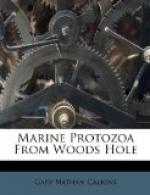The number of species of Cothurnia has become so great that the difficulty in placing forms is almost sufficient to discourage the systematist; as Buetschli well remarks, the variations in the theca have been made the basis of new species so many times that the genus is almost as confused as Difflugia among the rhizopods or Campanularia among the hydroids. The length of cup, of stalk, the presence of annulations on stalk or cup, etc., have given rise to many specific names, the majority of which I believe can be discarded. According to such differentials the same branch of an alga holding a hundred specimens of Cothurnia crystallina yield 10 or 12 species, whereas they are merely growth stages of one and the same form.
Cothurnia crystallina Ehr. Fig. 62.
Synonyms: Vaginicolla crystallina Ehr., Perty, Eichwald; V. grandis Perty; V. pedunculata Eichwald; Cothurnia crystallina Claparede & Lachmann, D’Udek.; C. gigantea D’Udek; C. maritima, C. crystallina Cohn; C. grandis Meresch.
The form of the cup shows the greatest differences; sometimes it is cylindrical, sometimes elongate thimble-shape, sometimes pouch-shape, corrugated or smooth on the sides, and wavy or smooth on border. Frequently the basal part becomes stalk-like, but this is very short. When present, the stalk may or may not have a knob-like swelling. The animal within the cup may or may not be borne on a stalk, and this stalk may or may not be knobbed. The cups are colorless or brown. The animal is very contractile and may stretch half its length out of the cup or retract well into it. There is no operculum. The length of the cup varies from 70 mu to 200 mu (C. gigantea; Vag. grandis, etc.). From Entz.
There is nothing to add to Entz’s characterization of this species, which is found both in fresh and salt water. The variability of the cup and stalk is quite noticeable in the Woods Hole forms.
[Illustration: Fig. 62.—Cothurnia crystallina.]
Cothurnia imberbis Ehrenberg, var. curvula Entz. Fig. 63.
Synonyms: C. imberbis Kent et al.;
C. curvula Entz; C. socialis
Gruber?
The lorica is swollen posteriorly, narrowest at the oral margin, bent on its axis and is supported on a short stalk. It is perfectly smooth and without annulations. The animal itself has no definite stalk. When fully expanded the animal emerges but slightly from the margin of the cup. Fresh and salt water. On red algae. Dimensions of Woods Hole form: Cup 50 to 55 mu long; greatest diameter 22 mu; length of stalk 4 to 5 mu.
[Illustration: Fig. 63.—Cothurnia imberbis.]
Cothurnia nodosa Claparede & Lachmann. Fig.64.
A. Smooth cup.—Cothurnia maritima Ehr., Eichwald, Stein, Kent.
B. Cross-ringed cup.—C.
pupa Eichwald, Stein, Cohn; C. nodosa
Cl & L.; V.
crystallina Entz ’78; C. pontica Meresch.,
Kent; C. cohnii
and pupa Kent; C. longipes Kellicott
’94.




